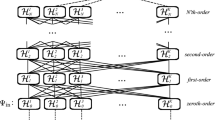Summary
Schwinger’s action (dynamical) principle for transition amplitudes, in quantum mechanics and field theory, is derived for long-range interactions by using the unescapable fact that a scattering out-(in-) state when translated forward (backward) in time for large positive (negative) times may stilldepend on the quantum-mechanical coupling parameter. For such interactions, the dynamical principle is different from the conventional one used extensively historically in the literature. As a corollary to our main result we show that the integrand in the Feynman path integral formulation is not simply given by exp [i[Action]]. Applications of the derived results are then given to the specific cases for the Coulomb interaction and to quantum electrodynamics.
Riassunto
Si deriva il principio (dinamico) dell’azione di Schwinger per le ampiezze di transizione, nella meccanica quantistica e la teoria dei campi, per interazioni a lungo raggio tenendo conto che inevitabilmente uno stato di scattering verso l’esterno (verso l’interno) quando è traslato in avanti (all’indietro) per grandi tempi positivi (negativi) può ancora dipendere dal parametro di accoppiamento quantomeccanico. Per queste interazioni, il principio dinamico è diverso da quello convenzionale usato estensivamente storicamente nella letteratura. Come corollario al nostro risultato principale si mostra che l’integrando nella formulazione dell’integrale del cammino di Feynman non è dato semplicemente da exp [i[Action]]. Si applicano i risultati derivati ai casi specifici per l’interazione di Coulomb all’elettrodinamica quantistica.
Реэюме
Выводится (динамический) принцип действия Щвингера для амплитуд пе-рехода в квантовой механике и теории поля для длиннодействуюших вэаимодействий, испольэуя тот факт, что выходяшие (входяшие) состояния рассеяния, когда перемешаются вперед (наэад) во времени для больщих положительных (отрицательных) времен, могут ешё эависеть от квантовомеханическ ого параметра свяэи. Для таких вэаимодействий динамический принцип отличается от обычного принципа действия, который ранее интенсивно испольэовался в литературе. Мы покаэываем, что подынтегральное выражение в формулировке фейнмановского интеграла по траектории не определяется просто выражением: exp [i[Действие]]. Предложенный подход применяется к специальным случаям кулоновского вэаимодействия и к квантовой злектродимнамике.
Similar content being viewed by others
References
J. Schwinger:Proc. Natl. Acad. Sci. USA,37, 452, 455 (1951);Phys. Rev.,82, 914 (1951);91, 713, 728 (1953);92, 1283 (1953);93, 615 (1954);94, 1362 (1954).
J. Schwinger:Lectures given at Stanford University (1956) (unpublished);Lectures given at Brandeis University (1960)Summer Institute in Theoretical Physics.
Cf.S. Weinberg:Rev. Mod. Phys.,52, 515 (1980);A. Salam:Rev. Mod. Phys.,52, 525 (1980);S. L. Glashow:Rev. Mod. Phys.,52, 539 (1980).
L. D. Faddeev andV. N. Popov:Phys. Lett. B,25, 29 (1967);A. Salam andJ. Strathdee:Nuovo Cimento A,11, 397 (1972).
C. Sommerfield:Physica (Utrecht) A,96, 309 (1979).
R. P. Feynman andA. R. Hibbs:Quantum Mechanics and Path Integrals (McGraw-Hill, New York, N. Y., 1960).
T. D. Lee andC. N. Yang:Phys. Rev.,128, 885, 899 (1962).
C. S. Lam:Nuovo Cimento,38, 1 (1965).
Cf.L. D. Faddeev: inMethods in Field Theory, edited byR. Balian andJ. Z. Justin (North-Holland, Amsterdam, 1981).
J. D. Dollard:J. Math. Phys. (N. Y.),5, 729 (1964);J. D. Dollard andG. Velo:Nuovo Cimento,45, 801 (1966);J. D. Dollard:J. Math. Phys., (N. Y.) 14, 708 (1973).
See alsoE. B. Manoukian:Fortschr. Phys.,32, 315 (1984);S. S. Schweber:Phys. Rev. D,7, 3114 (1973).
N. Papanicolaou:Phys. Rep. C,24, 230 (1976);Nucl. Phys. B,75, 483 (1974).
See alsoS. Weinberg:Phys. Rev. B,140, 516 (1965).
P. Kulish andL. Faddeev:Theor. Math. Phys.,4, 153 (1970).
H. D. Dahmen, B. Scholz andF. Steiner:Nucl. Phys. B,202, 365 (1982).
V. Chung:Phys. Rev. B,140, 1110 (1965).
Author information
Authors and Affiliations
Additional information
Work supported by a Department of National Defence Award under CRAD No. 3610-637: F4122.
Rights and permissions
About this article
Cite this article
Manoukian, E.B. Quantum action principle and path integrals for long-range interactions. Nuov Cim A 90, 295–307 (1985). https://doi.org/10.1007/BF02730406
Received:
Published:
Issue Date:
DOI: https://doi.org/10.1007/BF02730406




